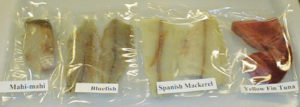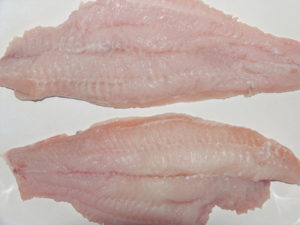Packaging suitability for varied products
Different types of packaging can have marked effects on the shelf life and quality of seafood products. Seafood processors and distributors can benefit from a research-based understanding of which packaging techniques are best suited to a variety of products.
Ongoing research conducted on various packaging systems is identifying the most effective packaging methods. (Read part 1 here.)
Atmospheric packaging
Skin packaging system

An innovative vacuum skin packaging system that included a surface thermal treatment was tested on fillets of Atlantic pomfret (Brama brama) stored at 4 degrees-C for up to 19 days. The results were compared with traditional vacuum packaging carried out in parallel. The investigation rated the packages on three sensory features, five biochemical parameters and three microbiological parameters.
The vacuum skin packaging led to significantly higher retention and a 12-day shelf life compared with seven days of shelf life from traditional vacuum packaging and five days for a control batch kept in air.
Cling film, aluminum foil
The effects of cling film and aluminum foil on the composition and quality changes in sea bass, (Dicentrarchus labrax), stored at a chill temperature of 4 degrees-C were also studied. The fish were stored in ice, in boxes without ice, wrapped in aluminum foil and wrapped in cling film.
The observed sensory shelf life of the seabass was 16 days in ice, four days in boxes without ice, eight days in aluminum foil and eight days in cling wrap.
Catfish – varied packaging methods
Fillets from farm-raised channel catfish (Ictalurus punctatus) were packaged by the following methods: polyvinylidine chloride film over wrapping, vacuum packaging and vacuum skin packaging. The fillets were stored for 90 days at minus-28 degrees-C. The packaging method did not have a significant effect on lipid oxidation or sensory evaluations of the fillets.
Vaccum pack, steam processing
In another study, mussels were vacuum packaged and processed in a steam over pressure retort. The total process time was 35 minutes. The product was rated as excellent by a sensory panel and remained in good condition after storage for one year at room temperature.
Modified-atmosphere packaging
Effects on bacteria
The effects of packaging methods on the growth of (Listeria monocytogenes) at 3 and 7 degrees-C in fresh and smoked trout (Onchorynchus mykiss) were monitored for 30 days. The inoculated samples were packaged under air, nitrogen, vacuum or nitrogen gas flush with vacuum atmosphere.
The results showed that L. monocytogenes grew on all packaged trout samples at 7 degrees-C but not 3 degrees-C. Modified-atmosphere packaging did not control the growth of the endogenous microflora, which reached high levels in all samples by day 10. The bacteria did not grow on the hot smoked trout at 3 degrees-C but increased from 1,000 to 3,000 colony-forming units at 10 days, and to 10 million at 30 days of storage at 10 degrees-C.
Smoked trout in all of the tested packaging methods retained an acceptable aroma and color for 30 days under both storage temperatures. Because L. monocytogenes grew to high levels at 7 degrees C, the product could pose a food safety risk.
Catfish

The shelf life of refrigerated fillets of catfish (Clarias gariepinus) was determined at 2 degrees-C using vacuum packaging and oxygen-permeable packaging. The oxygen-permeable packaging provided a storage life of four days, while the vacuum-packaged product had a shelf life of six to eight days.
Trout, herring
The quality of rainbow trout (Onchorynchus mykiss) fillets and Baltic herring (Clupea harengus membras) in over-wrapped packages of polystyrene or wood fiber, vacuum packages and gas packages (35 percent carbon dioxide, 32.5 percent argon, 32.5 percent nitrogen; 35 percent carbon dioxide, 65 percent argon; or 40 percent carbon dioxide, 60 percent nitrogen) stored at 2 degrees-C were compared.
Mesophilic bacteria, which grow best in temperatures of 15 to 40 degrees-C, grew most quickly in over-wrapped packaged fillets and more slowly in the vacuum- and gas-packaged fillets. Overwrapped herring fillets had the least drip formation during storage, while gas-packaged herring had the greatest. Drip loss was very small in all packaged trout fillets.
The sensory quality of both species deteriorated faster in the over-wrapped and vacuum packages than in the gas packages. The sensory quality of the trout and herring in the three types of gas packages was similar. Argon gas had no effect on shelf life.
Another study on rainbow trout stored at 1 degrees-C compared modified-atmosphere packaging (MAP) to over-wrapped and vacuum packages. The product packed in 10 percent oxygen, 50 percent carbon dioxide, 40 percent nitrogen/argon had a shelf life of 16 days, while the over-wrapped and vacuum-packaged products had six- and 10-day shelf lives, respectively.
Tilapia
The effects of modified atmospheres with combinations of carbon dioxide and nitrogen, and 100 percent air on the shelf life of tilapia fillets packaged in high-barrier film bags were evaluated at 4 degrees-C. Fillets packaged in air spoiled after nine days, as indicated by sensory characteristics, and had high microbial counts. When levels of carbon dioxide were increased from 25 to 75 percent, the shelf life was extended four to 21 days over that of fillets packaged under 100 percent air.
Mackerel
Chub mackere (Scomber japonicus) were packaged in 70 percent carbon dioxide, 30 percent nitrogen and compared against a vacuum-packaged control at 2 degrees-C. Based upon sensory and biochemical indices, the MAP was more effective than vacuum packaging for preservation of the mackerel.
The MAP-packaged fish exhibited slower spoilage, with fillets remaining acceptable up to approximately 21 days of storage, as opposed to a nine- or 10-day shelf life extension in the vacuum-packaged control.
Hake
A somewhat similar shelf life study using gas mixtures containing oxygen, nitrogen and carbon dioxide was performed with slices of hake (Merluccius merluccius) stored at 2 degrees-C. Important differences were found between MAP-stored and air-stored products.
The shelf life of hake stored under MAP conditions in the highest concentrations of carbon dioxide was extended from 14 to 21 days. Differences included a reduction in bacterial counts and off-odors.
Fish salad
The shelf life of fish salads made with rainbow trout in modified-atmosphere packaging and air packaging was studied using sensory evaluation. Control packages were no longer acceptable at the seventh day of storage. However, MAP samples were not rejected until the 14th day of storage. MAP decreased the microbial activity and increased sensory scores.
Leakage risks
Leakage in modified-atmosphere packages can cause microbial risk and accelerated chemical and autolytic spoilage. Leakage is often caused by improper sealing or mechanical damage during handling and transport.
If a MAP package leaks, the gas atmosphere changes and the shelf life of the product is usually decreased. In most cases oxygen, which is harmful to the product, enters the package, while carbon dioxide escapes.
Packaged products can lose quality more rapidly in leaking gas packages than in tight-sealed air packages. Leakage of MAP packages can be difficult to detect and is often only discovered after food spoilage becomes obvious due to the presence of off-odors or mold. Processors should implement packaging integrity testing programs that are reliable, accurate and rapid, but whose use is statistically designed to be cost effective.
(Editor’s Note: This article was originally published in the November/December 2008 print edition of the Global Aquaculture Advocate.)
Now that you've finished reading the article ...
… we hope you’ll consider supporting our mission to document the evolution of the global aquaculture industry and share our vast network of contributors’ expansive knowledge every week.
By becoming a Global Seafood Alliance member, you’re ensuring that all of the pre-competitive work we do through member benefits, resources and events can continue. Individual membership costs just $50 a year. GSA individual and corporate members receive complimentary access to a series of GOAL virtual events beginning in April. Join now.
Not a GSA member? Join us.
Author
-

George J. Flick, Jr., Ph.D.
Food Science and Technology Department
Virginia Tech/Virginia Sea Grant (0418)
Blacksburg, Virginia 24061 USA[117,100,101,46,116,118,64,103,107,99,105,108,102]
Tagged With
Related Posts

Intelligence
An examination of seafood packaging
Some substances can migrate from plastics and other seafood packaging materials into the product. Even if the substances are not harmful, they can affect the flavor and acceptability of the food.

Innovation & Investment
Aquaculture Exchange: Dawn Purchase, part 2
The Marine Conservation Society’s aquaculture program manager discusses what consumers ultimately need to know about aquaculture, responsible production and eco-labels. She also looks at NGOs making a difference in the global seafood industry and where she finds innovation in action.

Responsibility
Assessing culture potential of red emperor snapper in New Caledonia
The red emperor snapper, known as “pouatte” in New Caledonia, is valuable throughout its broad geographic range and a highly valued food fish locally. Declining wild catches and market demand have provided the incentive to carry out technical feasibility studies to determine its commercial aquaculture potential.

Intelligence
Critical decisions for shrimp harvesting and packing, Part 3
In this final installment of Hervé Lucien-Brun’s comprehensive three-part series, the author details the final steps in the process of taking farmed shrimp to the marketplace. Here we take a look at the proper protocols for receiving at the processing plant, weighing, grading and freezing.

